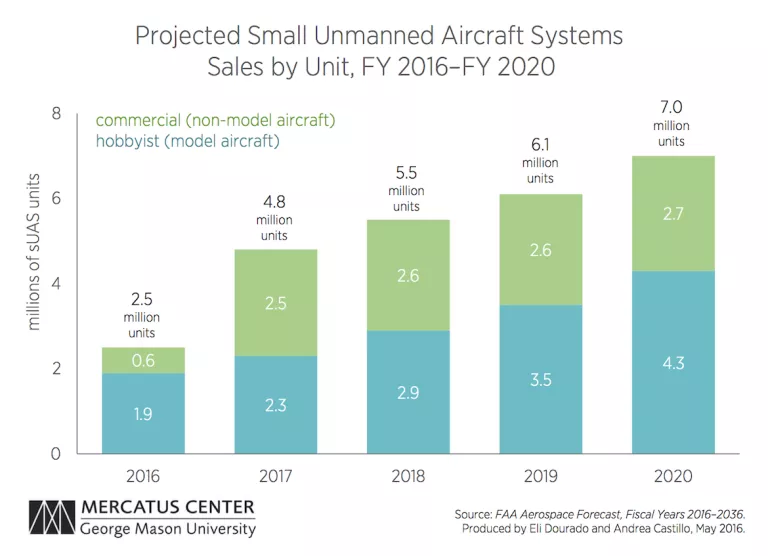- | Technology and Innovation Technology and Innovation
- | Data Visualizations Data Visualizations
- |
FAA Projections Reflect Deep Uncertainty about the Effect of Regulations on Drone Adoption
In March of this year, the first FAA-approved autonomous commercial drone delivery to an urban residence took place in Nevada. This milestone highlights the exciting opportunities that unmanned aircraft systems (UAS) can present. If we get our policies right, UASs can yield dividends in cost savings and economic growth in areas like consumer delivery, agriculture, industrial management, and journalism. A new FAA report suggests that a poorly considered regulatory regime could severely inhibit the growth of this promising industry before it has a chance to take flight.
In March of this year, the first FAA-approved autonomous commercial drone delivery to an urban residence took place in Nevada. This milestone highlights the exciting opportunities that unmanned aircraft systems (UAS) can present. If we get our policies right, UASs can yield dividends in cost savings and economic growth in areas like consumer delivery, agriculture, industrial management, and journalism. A new FAA report suggests that a poorly considered regulatory regime could severely inhibit the growth of this promising industry before it has a chance to take flight.

This week’s charts use data from a recent Federal Aviation Administration report titled FAA Aerospace Forecast, Fiscal Years 2016–2036, and show that even the FAA doesn’t know what effect its regulations will have on small UAS (sUAS) adoption over the next five years.
The agency’s report features two independently prepared forecasts. Both forecasts assume the same operating limitations for small UAS during the next five years: daytime operations, within visual line of sight, and a single pilot operating only one small UAS at a time. The independent estimates wildly diverged from each other because of the deep uncertainty generated by these regulations.
The first chart displays the FAA’s projections of the number of sUAS units that will be sold from 2016 through 2020. The total number of projected model aircraft sales to noncommercial hobbyist operators are displayed in teal, while the projected sales of commercial sUAS units are displayed in green. The total of both categories is displayed on top of the bar for each year. The chart shows that the FAA expects roughly 7 million sUAS units to be sold by 2020, constituted of roughly 4.3 million noncommercial aircraft and 2.7 million commercial aircraft.
In addition to this sales estimate, the FAA independently estimated the size of the operational commercial sUAS fleet in the US over the next five years. The agency expects that its final regulations will bifurcate the small drone market into two major categories: one “higher end” market consisting of units with an average sales price of approximately $40,000, and the second “lower end” market of crafts with an average sales price of roughly $2,500.
The second chart displays the report’s projections of total “higher end” sUAS units in purple and “lower end” sUAS units in gold. The FAA states that it expects roughly 90 percent of the demand for sUAS units will be satiated by cheaper crafts. By 2020, the agency expects that the total US sUAS fleet will consist of around 542,500 units.
The FAA’s two independent projections of sUAS adoption in the US are wildly inconsistent. The agency projects that 7 million sUAS units will be sold by 2020, of which 2.7 million will be commercial aircraft. Yet the agency only expects that around half a million, or 20 percent of all commercial sUAS units they estimate will be sold, will constitute the US fleet of sUAS by 2020.
The third chart compares the data from the first and second charts. The total number of projected commercial (nonhobbyist) sUAS unit sales are displayed in blue, while the total projected sUAS fleet (lower end and higher end) is displayed in red. Year after year, the FAA projects that the US sUAS fleet will comprise a slim portion of total sUAS sales.
The inconsistency in these projections is understandable. The market for sUAS is still nascent, and the effect of the FAA’s regulations on the industry’s viability is unknown. It makes sense that two independent estimates might reach different conclusions about the health of the new industry after the imposition of unprecedented regulations.

